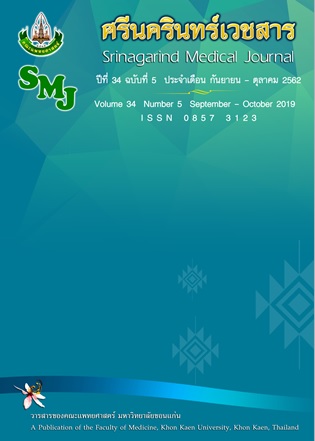Laparoscopic Radical Prostatectomy: Initial Experience in Srinagarind Hospital
Keywords:
มะเร็งต่อมลูกหมาก, การส่องกล้องช่องท้อง, ระยะเวลาการเรียนรู้, ประสบการณ์เบื้องต้น, Prostate cancer, Laparoscopy, Learning curve, Early experienceAbstract
การผ่าตัดมะเร็งต่อมลูกหมากด้วยการส่องกล้อง: ประสบการณ์เริ่มแรกในโรงพยาบาลศรีนรินทร์
วิเชียร ศิริธนะพล*, อุกฤษฎ ร่มไทรทอง, ปกรณ์ เกียรติโศภิษฐ์, ศุภณัฏฐ์ ลุมพิกานนท์, ขจิตร์ พาชีรัตน์
หน่วยศัลยศาสตร์ระบบปัสสาวะ ภาควิชาศัลยศาสตร์ คณะแพทยศาสตร์ มหาวิทยาลัยขอนแก่น ขอนแก่น ประเทศไทย
หลักการและวัตถุประสงค์: การรักษาที่เป็นมาตรฐานของมะเร็งต่อมลูกหมากระยะที่จำกัดอยู่เฉพาะที่คือการผ่าตัดเอาต่อมลูกหมากออก ด้วยการยอมรับที่มากขึ้นของการผ่าตัดแบบลุกล้ำน้อย การผ่าตัดต่อมลูกหมากออกด้วยการส่องกล้องจึงได้เข้ามามีบทบาทและเป็นหัตถการที่มีประสิทธิภาพในศัลยแพทย์ที่มีประสบการณ์ การศึกษานี้รายงานประสบการณ์เริ่มแรกของการผ่าตัดต่อมลูกหมากออกด้วยการส่องกล้องที่โรงพยาบาลศรีนครินทร์
วิธีการศึกษา: เป็นการศึกษาจากเวชระเบียนผู้ป่วย 20 ราย ที่เป็นมะเร็งต่อมลูกหมากที่จำกัดอยู่เฉพาะที่ที่ได้รับการผ่าตัดต่อมลูกหมากออกด้วยการส่องกล้องโดยศัลยแพทย์ระบบปัสสาวะหนึ่งคน ที่โรงพยาบาลศรีนครินทร์ในช่วง ตุลาคม พ.ศ. 2559 ถึง กุมภาพันธ์ พ.ศ. 2562 โดยศึกษาข้อมูลทั่วไปของผู้ป่วย รายละเอียดของการผ่าตัด และภาวะแทรกซ้อนจากการผ่าตัด
ผลการศึกษา: อายุเฉลี่ยของผู้ป่วยคือ 67.5 ปี (57-76) ค่าเฉลี่ยของระดับมะเร็งต่อมลูกหมากในกระแสเลือดอยู่ที่ 14.1 (6-39) ผู้ป่วย 7 รายได้รับการรักษาด้วยการให้ยาระงับฮอร์โมนเพศชายก่อนการผ่าตัด เวลาเฉลี่ยของการผ่าตัดและปริมาณการเสียเลือดเฉลี่ยของการผ่าตัดคือ 180 นาที (120-330) และ 400 มิลลิลิตร (100-2,000) ตามลำดับ มีผู้ป่วยเพียง 1 ราย ที่ต้องเปลี่ยนเป็นผ่าตัดแบบเปิดเนื่องจากสัญญาณชีพที่ไม่คงที่ ระยะเวลาเฉลี่ยในการนอนโรงพยาบาลอยู่ที่ประมาณ 5 วัน และไม่มีผู้ป่วยคนใดที่ต้องมานอนโรงพยาบาลซ้ำอีกรอบหลังการผ่าตัด มีผู้ป่วย 14 ราย (ร้อยละ 70) ที่ผลทางพยาธิวิทยาพบว่าไม่มีมะเร็งหลงเหลือ
สรุป: จากการศึกษาเริ่มแรกนี้พบว่าการผ่าตัดต่อมลูกหมากออกด้วยการส่องกล้องเป็นหัตถการที่มีความปลอดภัยและสามารถทำได้ ด้วยผลลัพธ์ทางด้านมะเร็งที่ยอมรับได้สำหรับมะเร็งต่อมลูกหมากระยะต้นที่โรงพยาบาลศรีนครินทร์
Background and objective: The standard treatment for clinically localized prostate cancer is surgery, radical prostatectomy. With the gaining acceptance of minimally invasive surgery, laparoscopic radical prostatectomy (LRP) has been determined to be an effective procedure in an experienced surgeon's hands. This study reported initial experience of LRP in Srinagarind hospital.
Methods: Medical records of 20 patients with clinically localized prostate cancer who underwent LRP by a single urologist in Srinagarind hospital between October 2016 to February 2019 were retrospectively reviewed. Patient characteristics, operative and peri-operative details, post-operative complications, and oncological outcomes were assessed.
Results: The median age was 67.5 years (57-76). The mean pre-operative prostate specific antigen level was 14.1 ng/mL (6-39). Seven patients were treated with GnRH agonist before the operation. The median operative time and blood loss were 180 min (120-330) and 400 ml (100-2000), respectively. Only one operation had to be converted to open surgery as a result of hemodynamic instability. The median hospital stay was 5 days and no one had to be readmitted. Fourteen patients (70%) were margin negative in the pathological specimen.
Conclusion: From this preliminary study, LRP is safe and feasible, with acceptable oncological outcomes for early prostate cancer in Srinagarind hospital.
References
Khuhaprema T. Current cancer situation in Thailand. Thai J Toxicology 2008;23:69-1.
Schuessler WW, Schulam PG, Clayman RV, Kavoussi LR. Laparoscopic radical prostatectomy: initial short-term experience. Urology. 1997; 50: 854–7.
Walsh P, Partin A, Epstein. Cancer control and quality of life following anatomical radical retropubic prostatectomy: results at 10 years. J Urol 1994; 152: 1831–6.
Zincke H, Oesterling J, Blute M, Bergstralh E, Myers R, Barret D. Long term (15years) results after radical prostatectomy for clinically localized (stage T2c or lower) prostate cancer. J Urol 1994; 152: 1850–7.
Trabulsi EJ, Guillonneau B. Laparoscopic radical prostatectomy. J Urol 2005; 173: 1072.
Guillonneau B, Vallancien G. Laparoscopic radical prostatectomy: initial experience and preliminary assessment after 65 operations. Prostate. 1999; 39: 71-5.
Abbou CC, Salomon L, Hoznek A, Antiphon P, Cicco A, Saint F, et al. Laparoscopic radical prostatectomy: preliminary results. Urology 2000; 55: 630-4.
Turk I, Deger S, Winkelmann B, Schonberger B, Loening SA. Laparoscopic radical prostatectomy. Technical aspects and experience with 125 cases. Eur Urol 2001; 40: 46-52; discussion 3.
Bollens R, Vanden Bossche M, Roumeguere T, Damoun A, Ekane S, Hoffmann P, et al. Extraperitoneal laparoscopic radical prostatectomy. Results after 50 cases. Eur Urol 2001; 40: 65-9.
Nualyong C, Srinualnad S, Taweemonkongsap T, Amornvesukit T. Laparoscopic radical prostatectomy: preliminary result of Thailand series. J Med Assoc Thai 2006; 89: 1440-6.
Ramart P, Leewansangtong S, Amornvesukit T, Taweemongkongsap T, Nualyong C, Sujijantararat P. Laparoscopic radical prostatectomy, Siriraj resident experiences: the first resident series in Thailand. J Med Assoc Thai 2011; 94: 50-4.
Rassweiler J, Sentker L, Seemann O, Hatzinger M, Rumpelt HJ. Laparoscopic radical prostatectomy with the Heilbronn technique: an analysis of the first 180 cases. J Urol 2001; 166: 2101-8.


